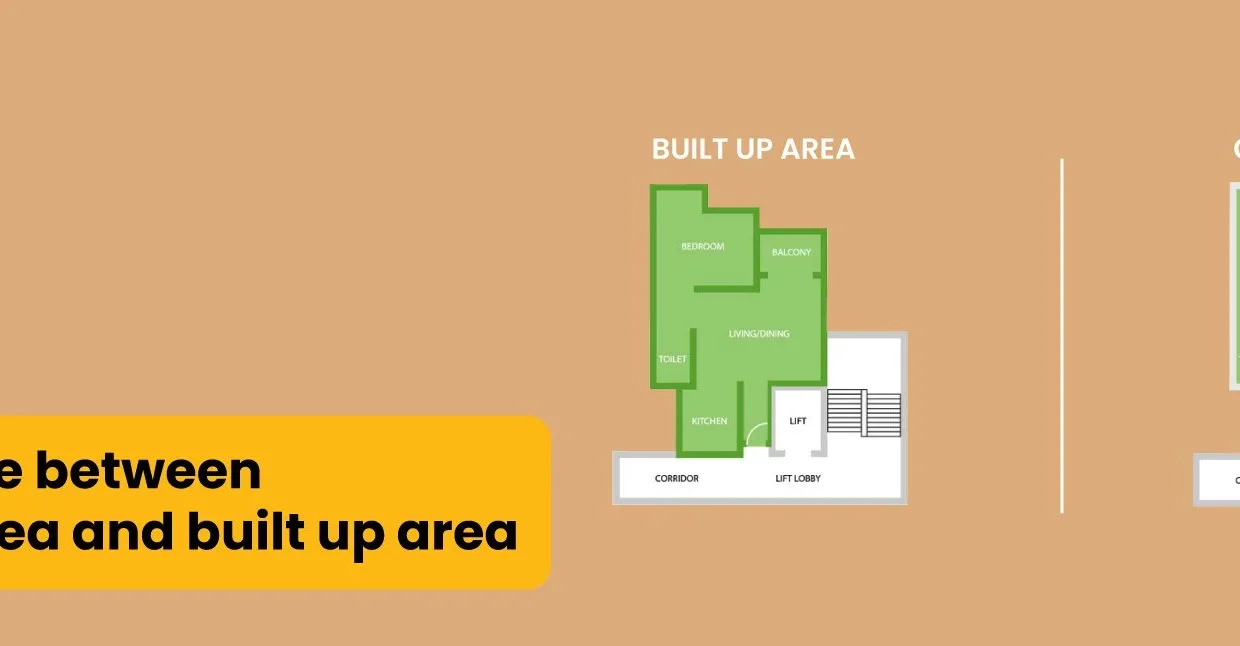
Abstract
You’ll encounter several real estate jargon while buying a home, such as a carpet area, built-up area, and super built-up area. These terms are used by brokers and planners to describe the area of an apartment. Understanding the jargon used by real estate brokers is essential for potential homebuyers to prevent expensive errors that might hurt their chances of finding the ideal house. In this article, we are trying to explain the difference between carpet area vs built-up area.
What is the Carpet Area?
The term “carpet area” refers to a space that may accommodate carpeting or otherwise useable space. The space between the inside walls is the carpet area. The carpet area does not cover common spaces like the lobby, elevator, etc.
The carpet area of an apartment is defined by the Real Estate Regulatory Authority (RERA) as the net usable floor area, excluding the areas covered by external walls, areas beneath services shafts, exclusive balconies or verandas, and exclusive open terraces, but including the areas covered by internal partition walls of the apartment.
Note: You will get a refund if the pre-construction project you reserved has a difference between the carpet area that was promised and the actual carpet area. The carpet area might change, and charges are made for that. However, the addition cannot exceed 3% of the guaranteed carpet area. RERA has established this cap.
How to Calculate Carpet Area?
The carpet area of a house is determined by adding up all of its rooms, including bathrooms, toilets, and the thickness of its interior walls, according to India’s real estate regulatory body RERA.
Carpet Area Formula = Area of Bedroom(s) + Area of Living Room(s) + Area of the Toilet(s) + Thickness of the Internal Walls
The thickness of the property’s outside walls, elevators, the verandah space, the balcony, etc. are not included in the carpet area. Simply add the areas of each living room, bedroom, and bathroom to get the carpet area of a home.
What is the Built-Up Area Definition?
In addition to the carpet surface, the built-up area also comprises other places. Take the wall’s thickness as an example. Built-up area means, in a nutshell, consisting of the carpet area, interior and exterior walls, and utility ducts. Compared to the carpet area, this phrase is used less frequently.
To put it simply, there is a difference between carpet area and built-up area since it is reasonable to estimate that 25 to 30 per cent of carpet area is built-up space. Therefore, it is reasonable to assume that the entire usable size of your apartment or house is roughly 650 square feet if your agent informs you that the built-up area is 900 square feet.
How to Calculate Built-up Area?
The exterior perimeter wall surfaces are used to gauge a building’s built-up area. It includes the carpet space, the thickness of the walls, and other inaccessible sections of the flat like the dry balcony, terrace, flower gardens, etc. It always extends beyond the carpeted area.
Built-up area = Carpet area + area of walls+area of balcony
Note: Typically, 15 to 30 per cent of carpet area is built up. The carpet area would not exceed 700 square feet if the built-up space were 1000 square feet.
What is a Super Built-up Area?
The super-built-up area means the property’s overall size, which includes shared spaces such as elevator lobbies, hallways, staircases, clubhouses, and other amenity areas. The property’s saleable area is another name for this. Sellers may or may not charge you for shared venues.
How to Calculate Super Built-up Area?
The super-built-up area of a property may be easily estimated if the carpet area and the loading factor are known. The loading factor, which is often represented as a percentage, is the difference between the property’s super built-up area and carpet area. The loading ratio typically ranges from 25% to 30% of the carpet surface.
For illustration, suppose a property has 20,000 square feet of carpet and a loading factor of 25%. The super built-up area may then be determined as follows:
Super Built-up Area = Carpet Area + Loading Factor = 20,000 + 5,000 (25% of 20,000) = 25,000 square feet
Note: Neither the super built-up area nor the built-up area includes the parking space that the property owner solely owns.
What is the Difference Between Built-up Area, Carpet Area and Super Built-up Area?
The following table will provide you with a clear understanding of the difference between Built-up Area, Carpet Area and Super Built-up Area.

Conclusion
So this was all about carpet area vs built-up area. Real estate agents or home builders often use these terms when you try to purchase a home. Never forget that to avoid being duped, you must understand the meaning of these phrases and the calculating method. For any more information about this topic or anything else related to real estate, contact our experts from PropCheck. They will be more than satisfied to help you on a priority basis.
Frequently Asked Questions
How much less is the carpet area from the built-up area?
Your apartment’s carpeted space normally accounts for 70-80% of the total built-up space.
Are the carpet area and square feet the same?
No, square feet is the unit of measurement in which carpet is represented.
